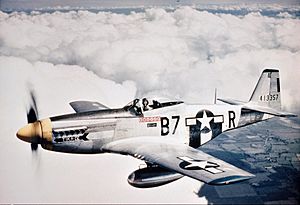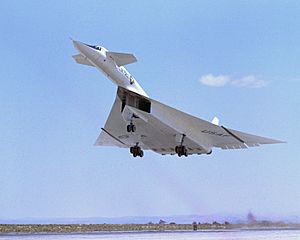North American Aviation facts for kids
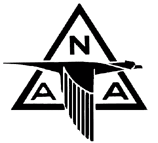 |
|
| Industry | Aerospace |
|---|---|
| Fate | Merger |
| Successor | North American Rockwell |
| Founded | 1928 |
| Founders | Clement Melville Keys |
| Defunct | March 1967 |
| Headquarters |
,
United States of America
|
|
Key people
|
|
| Parent | General Motors (1933–1948) |
North American Aviation (NAA) was a major American aerospace manufacturer that designed and built several notable aircraft and spacecraft. Its products included the T-6 Texan trainer, the P-51 Mustang fighter, the B-25 Mitchell bomber, the F-86 Sabre jet fighter, the X-15 rocket plane, the XB-70, the B-1 Lancer, the Apollo command and service module, the second stage of the Saturn V rocket, and the Space Shuttle orbiter.
Through a series of mergers and sales, North American Aviation became part of North American Rockwell, which later became Rockwell International and is now part of Boeing.
Contents
History
Early years
Clement Melville Keys founded North American on December 6, 1928, as a holding company that bought and sold interests in various airlines and aviation-related companies. However, the Air Mail Act of 1934 forced the breakup of such holding companies. North American became a manufacturing company, run by James H. "Dutch" Kindelberger, who had been recruited from Douglas Aircraft Company. NAA did retain ownership of Eastern Air Lines until 1938.
General Motors Corporation took a controlling interest in NAA and merged it with the General Aviation Manufacturing Corporation in 1933, but retained the name North American Aviation.
Kindelberger moved the company's operations from Dundalk, Maryland to Los Angeles, California, which allowed flying year-round, and decided to focus on training aircraft, on the theory that it would be easier than trying to compete with established companies on larger projects. Its first planes were the GA-15 observation plane and the GA-16 trainer, followed by the O-47 and BT-9, also called the GA-16.
World War II
The BC-1 of 1937 was North American's first combat aircraft; it was based on the GA-16. In 1940, like other manufacturers, North American started gearing up for war, opening factories in Columbus, Ohio, Dallas, Texas, and Kansas City, Kansas. North American ranked eleventh among United States corporations in the value of wartime production contracts.
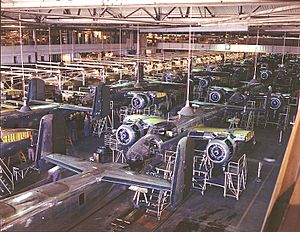
North American's follow-on to the BT-9 was the T-6 Texan trainer, of which 17,000 were built, making it the most widely used trainer ever. The twin-engine B-25 Mitchell bomber achieved fame in the Doolittle Raid and was used in all combat theaters of operation. The P-51 Mustang was initially produced for Britain as an alternative to the Curtiss P-40 Warhawk, which North American had declined to produce under licence. The derivative A-36 Mustang was developed as a ground attack aircraft and dive bomber. This was done, in part, to keep the airframe in production as the US Army Air Corps had not yet decided to purchase the type as a fighter.
A suggestion by the RAF that North American switch the P-51's powerplant from its original Allison engine to the Rolls-Royce Merlin engine may have been one of the most significant events in World War II aviation, as it transformed the P-51 into what many consider to be the best American fighter of the war.
Post-war years
Post-war, North American's employment dropped from a high of 91,000 to 5,000 in 1946. On V-J Day, North American had orders from the U.S. government for 8,000 aircraft. A few months later, that had dropped to 24.
Two years later in 1948, General Motors divested NAA as a public company. Nevertheless, NAA continued with new designs, including the T-28 Trojan trainer and attack aircraft, the F-82 Twin Mustang fighter, B-45 Tornado jet bomber, the FJ Fury fighter, AJ Savage, the revolutionary XB-70 Valkyrie Mach-3 strategic bomber, Shrike Commander, and T-39 Sabreliner business jet.
The Columbus, Ohio division of North American Aviation was instrumental in the exclusive development and production of the A-5 Vigilante, an advanced high speed bomber that would see significant use as a naval reconnaissance aircraft during the Vietnam War, the OV-10 Bronco, the first aircraft specifically designed for forward air control (FAC), and counter-insurgency (COIN) duties, and the T-2 Buckeye Naval trainer, which would serve from the late 1950s until 2008 and be flown in training by virtually every Naval Aviator and Naval Flight Officer in the US Navy and US Marine Corps for four decades. The Buckeye's name would be an acknowledgment to the state tree of Ohio, as well as the mascot of Ohio State University.
The North American F-86 Sabre started out as a redesigned Fury and achieved fame shooting down MiGs in the Korean War. Over 9,000 F-86s were produced. Its successor, the North American F-100 Super Sabre, was also popular.
Some 6,656 F-86s were produced in the United States, the most produced postwar military aircraft in the West, as well as another 2,500 elsewhere. To accommodate its Sabre production, North American opened facilities in a former Curtiss-Wright plant in Columbus, Ohio. It also moved into a former Consolidated-Vultee Aircraft plant at Downey, California, and in 1948, built a new plant at Downey. By the end of 1952, North American sales topped $315 million. Employment at the Columbus plant grew from 1,600 in 1950 to 18,000 in 1952.
The cancellation of the F-107 and F-108 programs in the late 1950s, as well as the cancellation of the Navaho intercontinental cruise missile program, was a blow to North American from which it never fully recovered.
Nuclear development
Atomics International was a division of North American Aviation which began as the Atomic Energy Research Department at the Downey plant in 1948. In 1955, the department was renamed Atomics International and engaged principally in the early development of nuclear technology and nuclear reactors for both commercial and government applications. Atomics International was responsible for a number of accomplishments relating to nuclear energy: design, construction and operation of the first nuclear reactor in California (a small aqueous homogeneous reactor located at the NAA Downey plant), the first nuclear reactor to produce power for a commercial power grid in the United States (the Sodium Reactor Experiment located at the Santa Susana Field Laboratory) and the first nuclear reactor launched into outer space by the United States (the SNAP-10A). As overall interest in nuclear power declined, Atomics International transitioned to non-nuclear energy-related projects such as coal gasification and gradually ceased designing and testing nuclear reactors. Atomics International was eventually merged with the Rocketdyne division in 1978.
Autonetics began in 1945 at North American's Technical Research Laboratory, a small unit in the Los Angeles Division's engineering department based in Downey, California. The evolution of the Navaho missile program resulted in the establishment of Autonetics as a separate division of North American Aviation in 1955, first located in Downey, later moving to Anaheim, California in 1963. The division was involved in the development of guidance systems for the Minuteman ballistic missile system.
Space program
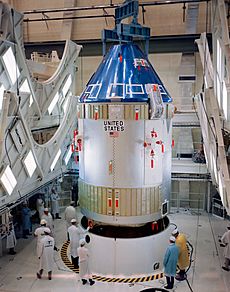
In 1955, the rocket engine operations were spun off into a separate division as Rocketdyne. This division furnished engines for the Redstone, Jupiter, Thor, Delta, and Atlas missiles, and for NASA's Saturn family of launch vehicles.
North American designed and built the airframe for the X-15, a rocket-powered aircraft that first flew in 1959.
In 1959, North American built the first of several Little Joe boosters used to test the launch escape system for the Project Mercury spacecraft. In 1960, the new CEO Lee Atwood decided to focus on the space program, and the company became the prime contractor for the Apollo command and service module, a larger Little Joe II rocket to test Apollo's launch escape system, and the S-II second stage of the Saturn V.
Merger and acquisition
The fatal Apollo 1 fire in January 1967 was partly blamed on the company. In September, it merged with Rockwell-Standard, and the merged company became known as North American Rockwell. During this period the company continued its involvement with the Apollo program, building the Command and Service modules for all eleven missions. Within two years the new company also was studying concepts for the Space Shuttle, and won the orbiter contract in 1972. In 1973, the company changed its name again to Rockwell International and named its aircraft division North American Aircraft Operations.
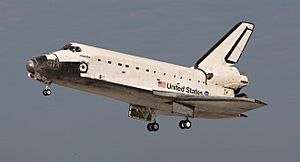
Rockwell International's defense and space divisions (including the North American Aviation divisions Autonetics and Rocketdyne) were sold to Boeing in December 1996. Initially called Boeing North American, these groups were integrated with Boeing's Defense division. Rocketdyne was eventually sold by Boeing to UTC Pratt & Whitney in 2005. UTC later sold Rocketdyne to Aerojet (GenCorp) in 2013.
Products
Aircraft
| Model name | First flight | Number built | Type |
|---|---|---|---|
| North American NA-16 | 1935 | 1,935 | Single piston engine trainer |
| North American O-47 | 1935 | 239 | Single piston engine observation airplane |
| North American BT-9 | 1936 | 149 | Single piston engine trainer |
| North American XB-21 | 1936 | 1 | Prototype twin piston engine medium bomber |
| North American BC-1 | 1937 | 270 | Single piston engine trainer |
| North American Harvard | 1938 | 1,463 | Single piston engine trainer |
| North American BT-14 | 1939 | 251 | Single piston engine trainer |
| North American T-6 Texan | 1939 | 15,495 | Single piston engine trainer |
| North American SNJ | 1939 | 3,867 | Single piston engine trainer |
| North American P-64 | 1939/1940 | 13 | Single piston engine fighter |
| North American NA-35 | 1940 | 1 | Prototype single piston engine trainer |
| North American NA-64 Yale | 1940 | 230 | Single piston engine trainer |
| North American A-27 | 1940 | 10 | Single piston engine attack airplane |
| North American B-25 Mitchell | 1940 | 9,890 | Twin piston engine medium bomber |
| North American P-51 Mustang | 1940 | 15,000+ | Single piston engine fighter |
| North American XB-28 | 1942 | 2 | Prototype twin piston engine medium bomber |
| North American A-36 | 1942 | 500 | Single piston engine attack airplane |
| North American F-82 Twin Mustang | 1945 | 272 | Twin piston engine escort fighter |
| North American Navion | 1946 | 1,109 | Single piston engine civilian airplane |
| North American FJ-1 Fury | 1946 | 33 | Single jet engine naval fighter |
| North American XSN2J | 1947 | 2 | Prototype single piston engine trainer |
| North American B-45 Tornado | 1947 | 143 | Quad jet engine bomber |
| North American F-86 Sabre | 1947 | 9,860 | Single jet engine fighter |
| North American AJ Savage | 1948 | 143 | Twin piston engine naval attack airplane |
| North American T-28 Trojan | 1949 | 1,948 | Single piston engine trainer |
| North American F-86D Sabre | 1949 | 2,847 | Single jet engine interceptor fighter |
| North American YF-93 | 1950 | 2 | Prototype single jet engine fighter |
| North American FJ-2 Fury | 1951 | 203 | Single jet engine naval fighter |
| North American XA2J Super Savage | 1952 | 1 | Prototype twin turboprop engine naval attack airplane |
| North American F-100 Super Sabre | 1953 | 2,294 | Single jet engine fighter |
| North American FJ-3 Fury | 1953 | 538 | Single jet engine naval fighter |
| North American X-10 | 1953 | 13 | Experimental twin jet engine uncrewed airplane |
| North American FJ-4 Fury | 1954 | 374 | Single jet engine naval fighter |
| North American F-107 | 1956 | 3 | Prototype single jet engine fighter |
| North American T-2 Buckeye | 1958 | 529 | Twin jet engine trainer |
| North American A-5 Vigilante | 1958 | 167 | Twin jet engine naval attack airplane |
| North American Sabreliner | 1958 | 800+ | Twin jet engine business airplane |
| North American X-15 | 1959 | 3 | Experimental single rocket engine aircraft |
| North American XB-70 Valkyrie | 1964 | 2 | Prototype six jet engine strategic bomber |
| North American Rockwell OV-10 Bronco | 1965 | 360 | Twin turboprop engine observation airplane |
Crewed spacecraft
- Apollo command and service module
- North American DC-3
- Skylab Rescue
- Space Shuttle
Missiles and rockets
- AGM-28 Hound Dog
- AGM-64 Hornet
- RTV-A-3 NATIV
- SM-64 Navaho
- S-II second stage of the Saturn V launch vehicle
- Little Joe (rocket)
- Little Joe II
Unmanned aerial vehicles
- North American MQM-42 Redhead-Roadrunner
Projects
- North American NA-116 (four-engined long range bomber project only)
- North American NA-148 (commercial transport project only)
- North American NA-237 (fighter bomber project only)
- North American NA-323 (project only for VFX F-14 program)
- North American NA-365 (carrier on board delivery - project only)
- North American NA-400 (naval strike attack project for USN)
- North American NA-420 (V/STOL Support aircraft project for USN)
- North American XF-108 Rapier
See also
 In Spanish: North American Aviation para niños
In Spanish: North American Aviation para niños


